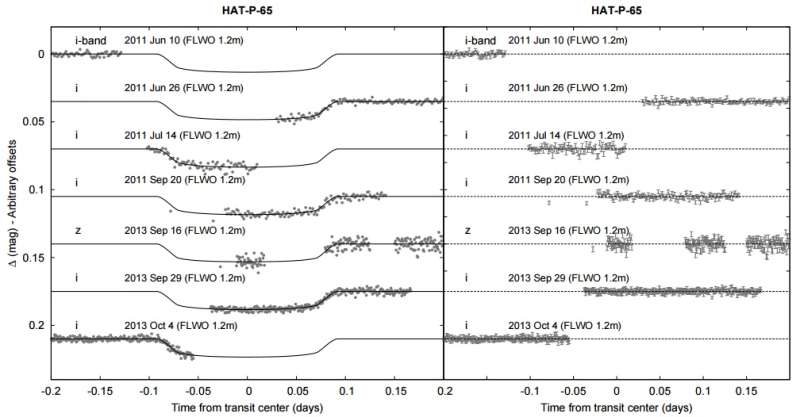September 13, 2016 report
Astronomers discover two new inflated 'hot Jupiters'

(Phys.org)—An international team of astronomers led by Joel Hartman of Princeton University has detected two new "hot Jupiter" exoplanets, less massive than our solar system's biggest planet, but with a radius larger than they should have. The findings are reported in a paper published Sept. 9 on arXiv.org.
The newly found exoworlds, designated HAT-P-65b and HAT-P-66b, were classified as "hot Jupiters" as they are gas giant planets similar in characteristics to Jupiter, with orbital periods of less than 10 days. They have high surface temperatures as they orbit their host stars very closely. However, the new alien worlds are much larger in diameter than expected, which led astronomers to conclude that these planets must have undergone an inflation process.
HAT-P-65b and HAT-P-66b were detected by the Hungarian-made Automated Telescope Network (HATNet). The team also conducted follow-up spectrographic and photometric observations to determine physical characteristics of these planets.
According to the research, the exoplanets orbit two distant, moderately evolved stars named HAT-P-65 and HAT-P-66 that are approaching the end of their main sequence lifetimes. HAT-P-65 is 5.46 billion years old, while HAT-P-66's estimated age is 4.66 billion years. They are located some 2,750 and 3,000 light years away respectively. Both stars are similar in size, having radii of about 1.87 solar radii and mass of approximately 1.25 solar masses.
The newly discovered planets are less massive than Jupiter—HAT-P-65b has only half the mass of Jupiter, while HAT-P-66b about 78 percent the mass of our gas giant. The orbital period of this two worlds equals 2.60 and 2.97 days correspondingly.
What is the most intriguing about these two extrasolar planets is that they are larger than they should be when compared to typical gas giants. HAT-P-65b has a radius of nearly 1.9 Jupiter radii and HAT-P-66b is about 1.6 the size of Jupiter in diameter. This suggests that the two exoplanets are inflated gas giants.
However, further investigations and new detections are still needed to determine precisely what causes the inflation process in gas giant planets. Currently, possible explanations could be assigned to two different theories—scientists believe that the inflation is caused by deposition of energy from the host star or inhibited cooling of the planet.
"One way to make further progress on this problem is to build up a larger sample of inflated planets to identify patterns in their properties that may be used to discriminate between different theories," the researcher wrote in the paper.
The discovery of HAT-P-65b and HAT-P-66b, complemented by previous studies reporting the detection of inflated planets, allowed the team to find an important correlation between planetary radii and the fractional ages of parent stars, which makes the theory regarding the deposition of energy more plausible.
"The planets are both around moderately evolved stars, which we find to be a general trend—highly inflated planets with a radius larger than about 1.5 Jupiter radii have been preferentially found around moderately evolved stars compared to smaller-radius planets. (…) We conclude that, after contracting during the pre-main-sequence, close-in giant planets are re-inflated over time as their host stars evolve. This provides evidence that the mechanism responsible for this inflation deposits energy deep within the planetary interiors," the paper reads.
More information: HAT-P-65b and HAT-P-66b: Two Transiting Inflated Hot Jupiters and Observational Evidence for the Re-Inflation of Close-In Giant Planets, arXiv:1609.02767 [astro-ph.EP] arxiv.org/abs/1609.02767
Abstract
We present the discovery of the transiting exoplanets HAT-P-65b and HAT-P-66b, with orbital periods of 2.6055 d and 2.9721 d, masses of 0.527±0.083 MJ and 0.783±0.057 MJ and inflated radii of 1.89±0.13 RJ and 1.59+0.16−0.10 RJ, respectively. They orbit moderately bright (V=13.145±0.029, and V=12.993±0.052) stars of mass 1.212±0.050 M⊙ and 1.255+0.107−0.054 M⊙. The stars are at the main sequence turnoff. While it is well known that the radii of close-in giant planets are correlated with their equilibrium temperatures, whether or not the radii of planets increase in time as their hosts evolve and become more luminous is an open question. Looking at the broader sample of well-characterized close-in transiting giant planets, we find that there is a statistically significant correlation between planetary radii and the fractional ages of their host stars, with a false alarm probability of only 0.0041%. We find that the correlation between the radii of planets and the fractional ages of their hosts is fully explained by the known correlation between planetary radii and their present day equilibrium temperatures, however if the zero-age main sequence equilibrium temperature is used in place of the present day equilibrium temperature then a correlation with age must also be included to explain the planetary radii. This suggests that, after contracting during the pre-main-sequence, close-in giant planets are re-inflated over time due to the increasing level of irradiation received from their host stars. Prior theoretical work indicates that such a dynamic response to irradiation requires a significant fraction of the incident energy to be deposited deep within the planetary interiors.
© 2016 Phys.org




















